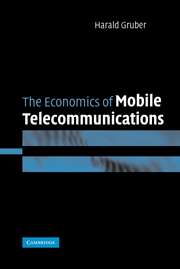Book contents
- Frontmatter
- Contents
- List of figures
- List of tables
- Preface
- List of abbreviations and acronyms
- 1 Introduction
- 2 Stylised features of the mobile telecommunications industry
- 3 The evolution of national markets for cellular mobile telecommunications services
- 4 The determinants of the diffusion of cellular mobile telecommunications services
- 5 Market conduct and pricing issues in mobile markets
- 6 Issues in radio spectrum management
- 7 The evolution of market structure in mobile telecommunications markets
- Appendix
- Bibliography
- Index
2 - Stylised features of the mobile telecommunications industry
Published online by Cambridge University Press: 22 September 2009
- Frontmatter
- Contents
- List of figures
- List of tables
- Preface
- List of abbreviations and acronyms
- 1 Introduction
- 2 Stylised features of the mobile telecommunications industry
- 3 The evolution of national markets for cellular mobile telecommunications services
- 4 The determinants of the diffusion of cellular mobile telecommunications services
- 5 Market conduct and pricing issues in mobile markets
- 6 Issues in radio spectrum management
- 7 The evolution of market structure in mobile telecommunications markets
- Appendix
- Bibliography
- Index
Summary
Introduction
Mobile telecommunications use radio waves, instead of wires, to connect users. Though the origins of wireless communications may be traced back to the second half of the nineteenth century, the earliest applications for mobile communications date back to the 1920s. After the Second World War, when the civilian use of wireless telecommunications resumed, several industrialised countries independently developed mobile telecommunications systems. These, however, suffered of a series of technical limitations that hampered their widespread use. Only during the 1980s did these problems begin to be surmounted, with the diffusion of cellular mobile telecommunications technology as it is known today. To fully appreciate the technological challenges mobile telecommunications had to surmount to become a widely spread technology, it is useful to briefly sketch the history of the technology in the context of the working principle of wireless communications. This chapter outlines the main driving forces of the mobile telecommunications industry and how they shape the evolution of the sector and gives some hints on the prospects for the future of the sector. The key issues will be dealt with in more detail in subsequent chapters. This chapter is organised as follows. Section 2.2 presents a brief history of the technological developments in the mobile telecommunications industry. Section 2.3 provides some notions of the different technologies available. Section 2.4 illustrates some of the main user trends in this fast-growing industry, while section 2.5 looks at the revenue side.
- Type
- Chapter
- Information
- The Economics of Mobile Telecommunications , pp. 9 - 64Publisher: Cambridge University PressPrint publication year: 2005



